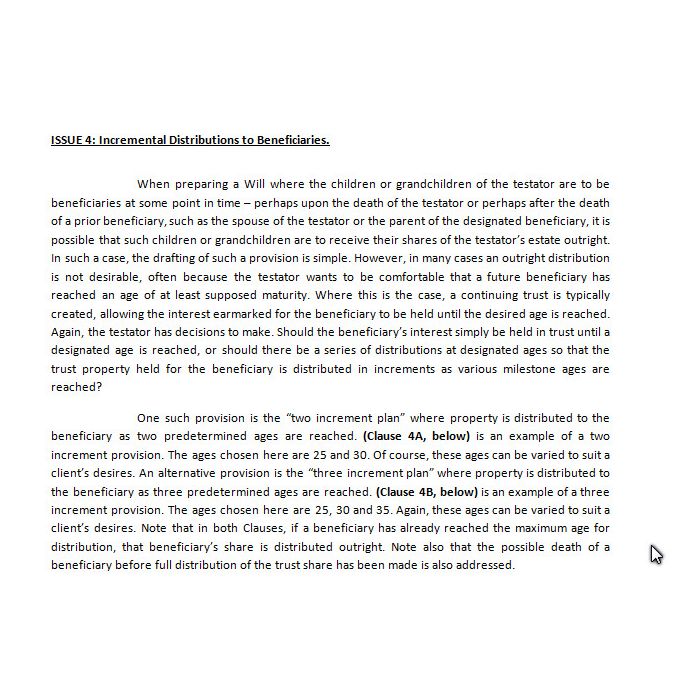Incremental Distributions to Beneficiaries Will Clauses (6 Pages)
When preparing a Will where the children or grandchildren of the testator are to be beneficiaries at some point in time – perhaps upon the death of the testator or perhaps after the death of a prior beneficiary, such as the spouse of the testator or the parent of the designated beneficiary, it is possible that such children or grandchildren are to receive their shares of the testator’s estate outright. In such a case, the drafting of such a provision is simple. However, in many cases an outright distribution is not desirable, often because the testator wants to be comfortable that a future beneficiary has reached an age of at least supposed maturity. Where this is the case, a continuing trust is typically created, allowing the interest earmarked for the beneficiary to be held until the desired age is reached. Again, the testator has decisions to make. Should the beneficiary’s interest simply be held in trust until a designated age is reached, or should there be a series of distributions at designated ages so that the trust property held for the beneficiary is distributed in increments as various milestone ages are reached?
2 Clauses To Address The Following Issues:
CLAUSE 1: Distribution Plan for Beneficiaries in Two Increments
CLAUSE 2: Distribution Plan for Beneficiaries in Three Increments
Incremental Distributions to Beneficiaries Will Clauses - 2 Clauses
- Distribution Plan for Beneficiaries in Two Increments
- Distribution Plan for Beneficiaries in Three Increments
When preparing a Will where the children or grandchildren of the testator are to be beneficiaries at some point in time – perhaps upon the death of the testator or perhaps after the death of a prior beneficiary, such as the spouse of the testator or the parent of the designated beneficiary, it is possible that such children or grandchildren are to receive their shares of the testator’s estate outright. In such a case, the drafting of such a provision is simple. However, in many cases an outright distribution is not desirable, often because the testator wants to be comfortable that a future beneficiary has reached an age of at least supposed maturity. Where this is the case, a continuing trust is typically created, allowing the interest earmarked for the beneficiary to be held until the desired age is reached. Again, the testator has decisions to make. Should the beneficiary’s interest simply be held in trust until a designated age is reached, or should there be a series of distributions at designated ages so that the trust property held for the beneficiary is distributed in increments as various milestone ages are reached?
One such provision is the “two increment plan” where property is distributed to the beneficiary as two predetermined ages are reached. (Clause 1) is an example of a two increment provision. The ages chosen here are 25 and 30. Of course, these ages can be varied to suit a client’s desires. An alternative provision is the “three increment plan” where property is distributed to the beneficiary as three predetermined ages are reached. (Clause 2) is an example of a three increment provision. The ages chosen here are 25, 30 and 35. Again, these ages can be varied to suit a client’s desires. Note that in both Clauses, if a beneficiary has already reached the maximum age for distribution, that beneficiary’s share is distributed outright. Note also that the possible death of a beneficiary before full distribution of the trust share has been made is also addressed.
Author:
Steven G. Siegel is president of The Siegel Group, a Morristown, New Jersey - based national consulting firm specializing in tax consulting, estate planning and advising family business owners and entrepreneurs. Mr. Siegel holds a BS from Georgetown University, a JD from Harvard Law School and an LLM in Taxation from New York University.
He is the author of several books, including: Planning for An Aging Population; Business Entities: Start to Finish; Taxation of Divorce and Separation; Income Taxation of Estates and Trusts, Preparing the Audit-Proof Federal Estate Tax Return, Putting It Together: Planning Estates for $5 million and Less, Family Business Succession Planning, Business Acquisitions: Representing Buyers and Sellers in the Sale of a Business; Dynasty Trusts; Planning with Intentionally-Defective Grantor Trusts; The Federal Gift Tax: A Comprehensive Analysis; Charitable Remainder Trusts, Grantor Trust Planning: QPRTs, GRATs and SCINs, The Estate Planning Course, The Retirement Planning Course, Retirement Distributions: Estate and Tax Planning Strategies; The Estate Administration Course, Tax Strategies for Closely-Held Businesses, and Tort Litigation Settlements: Tax and Financial Issues.
Mr. Siegel has lectured extensively throughout the United States on tax, business and estate planning topics on behalf of numerous organizations, including National Law Foundation, AICPA, CCH, National Tax Institute, National Society of Accountants, and many others. He has served as an adjunct professor of law at Seton Hall and Rutgers University law schools.
The Siegel Group provides consulting services to accountants, attorneys, financial planners and life insurance professionals to assist them with the tax, estate and business planning and compliance issues confronting their clients. Based in Morristown, New Jersey, the Group has provided services throughout the United States. The Siegel Group does not sell any products. It is an entirely fee-based organization.
Contact the Siegel Group through its president, Steven G. Siegel, e-mail: [email protected].


